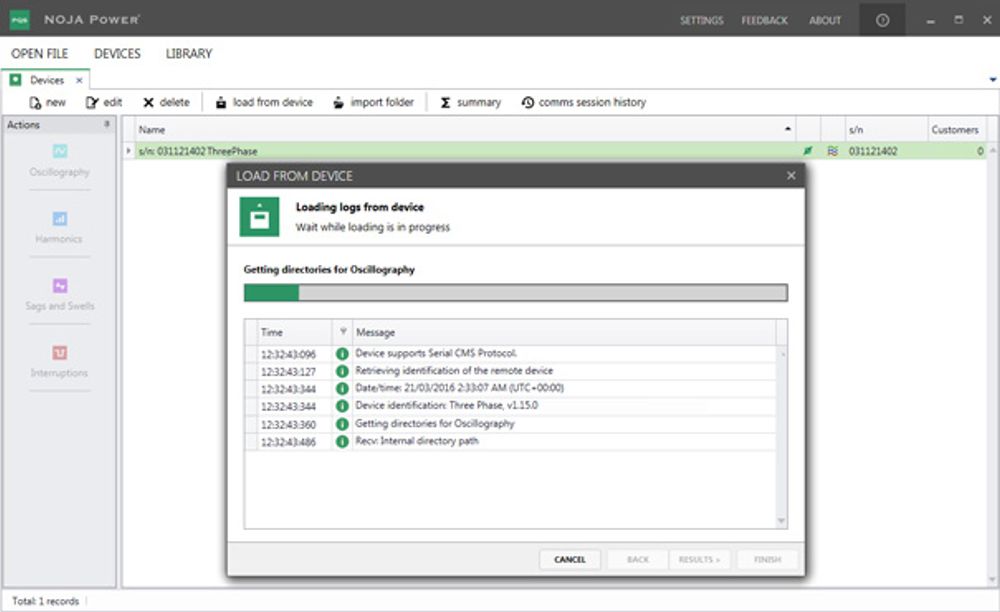Press Release
Published 03/2016
NOJA Power’s Power Quality Software upgrade enhances power quality and ACR trigger event analysis

Electrical switchgear engineers NOJA Power today announces a revision of its Power Quality Software (PQS), a power quality-analysis and optimization tool. Among other enhancements, PQS v1.0.15 now enables utility engineers to remotely import and then analyze, Comtrade-formatted data from trigger events recorded by the company’s OSM series Automatic Circuit Reclosers (ACR or “auto recloser”).
PQS v1.0.15 is part of suite of software power quality monitoring and analysis tools, running on PCs equipped with Windows XP and above and Microsoft .NET Framework version 4, which analyze data gathered by the NOJA Power ACR and RC-10 control and communication cubicle.
PQS is used to analyze effects on power quality due to harmonic distortion, interruptions and voltage sags & swells, allowing utilities to address the cause of these factors before they degrade assets or trigger regulatory body penalties. Such analysis is becoming increasingly important as the significant renewable energy distributed generation (for example, photovoltaic (PV) panels on domestic roofs) being connected to the distribution grid increases the possibility of harmonics which can compromise the quality of the electricity supply. The ability to collect and analyze power quality information remotely from distributed generation sources is becoming increasingly important as utilities come under greater pressure from regulators to maintain power quality within narrow guidelines.
PQS is also ideal for analysis of ACR trigger events allowing utilities to remotely modify protection schemes to limit reoccurrence and optimize distribution grid performance. PQS enables engineers to determine significantly more information about the cause of a trigger event than the standard fault profiles supplied by the RC-10 controller.
The RC-10 controller can now capture an oscillogram of the voltage and current waveform on all three phases when a specific trip or close event occurs. The controller measures Total Harmonic Distortion (THD), Total Demand Distortion (TDD) and harmonics voltages and currents up to the 15th harmonic allowing utility engineers to precisely determine the cause of the event. In addition, the RC-10 stores information relating to long and short duration interruptions as well as voltage variations occurring outside the user-set period of the oscillogram.
A USB Flash memory device can be connected to the RC-10 controller increasing the amount of oscillography data that can be collected. The oscillography data can then be accessed remotely and uploaded to a PC running PQS, eliminating the need for maintenance staff to visit the ACR site to retrieve the information.

The oscillography data gathered by the RC-10 controller is available with a configuration file (“.cfg”) and a data file (“.dat”) supplied in IEEE Std C37.111-1999 Comtrade Binary format. Because it adheres to an industry standard format, Comtrade data can be easily imported into other software applications and instruments to, for example, model the effect of the trigger event on non-ACR assets. Utilities can also use Comtrade data in PQS to recreate the original ACR data for closer analysis and even model the effect on the trigger event of modified protection schemes.
“Analysis of power quality is important for utilities as they seek to optimize the performance of existing networks and upgrade to smart grids,” says Neil O’Sullivan, NOJA Power’s Managing Director. “The OSM series auto reclosers incorporate as standard advanced monitoring of harmonics, current and voltage on all three phases of a feeder - which Is particularly important for this analysis. With this latest version of PQS, engineers can remotely gather this data, examine the information and then remotely reconfigure the auto reclosers to fine tune the network for optimum efficiency.”
NOJA Power’s OSM series ACRs are fundamental elements of smart grids and provide a comprehensive suite of automation features. The units perform voltage measurement on all six bushings, current measurement on all three phases, bidirectional protection and extensive power quality and data logging capability. The OSM series has been fully type-tested by independent laboratory KEMA in the Netherlands to ensure long life and reliability under the harshest environmental conditions. Since their introduction, the OSM series ACRs have been installed by utilities in over 84 countries around the world.
The RC-10 is a supervisory control and data acquisition (SCADA)-ready controller that provides a directional overcurrent, earth fault and sensitive earth fault relay, auto reclosing relay, instantaneous metering, event log, demand logger and remote terminal unit (RTU) for remote control in a single package.
Want to stay up to date with Electrical Distribution Technology?
Join our list for a free weekly technical bulletin, as we share our Global Electrical Engineering experience directly to your inbox.
Subscribe →